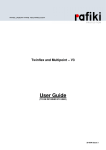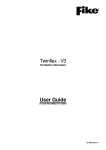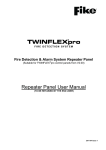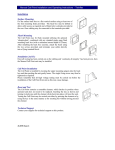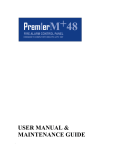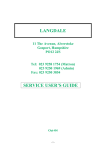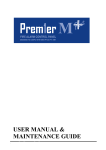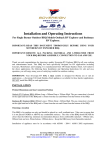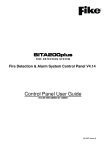Download Twinflex and Multipoint User Guide
Transcript
Twinflex and Multipoint User Guide 26-0340 Issue 1 1 Twinflex and Multipoint User Guide Rafiki Protection Limited Rafiki policy is one of continual improvement and the right to change a specification at any time without notice is reserved. Whilst every care has been taken to ensure that the contents of this document are correct at time of publication, Rafiki shall be under no liability whatsoever in respect of such contents. 2 Twinflex and Multipoint User Guide Contents Introduction . . . Purpose of the guide . Definitions . Responsible Person Competent Person Understanding the equipment System configuration . What to do if!!! . . The fire alarm sounds The buzzer sounds . . . . . . . . . . . . . . . . . . . . . . . . . . . . . . . . . . . . . . . . Installation Details . . . . 6 . . . . . . . . . . . . . . . . . . . . . . . . . . . . . . . . . . . . . . . . . . . . . . . . . . . . . . . . 7 7 7 User Responsibilities . . . . Introduction . . . . Routine testing . . . . Daily . . . . Weekly . . . . Quarterly . . . Annual . . . . Action by the User after a fire . Action by the User after any false alarm Action by the User following a fault . . . . . . . . . . . . . . . . . . . . 13 13 13 Log Book . . Event log . Weekly testing . Routine maintenance Modifications . . . . . . . . . . . 15 15 17 19 22 . . Operation . . . Normal . . Access Levels. . . 2 and 4 zone panels 8 zone panels . Fire Alarm . . On hearing the alarm . Accessing the controls . Silencing the alarms . Resetting the system . Sound alarms (evacuate) . Silence buzzer . Exit Access Level Two . Trouble shooting . . . . . . . . . . . . . . . . . 4 4 4 4 5 5 7 7 8 8 8 8 8 9 9 3 Twinflex and Multipoint User Guide Introduction Purpose of the Guide This guide is provided to enable the person responsible for the fire alarm system (see Definitions) to operate the system, undertake their responsibilities with regard to testing and maintenance of the system, and to record events and service/maintenance visits. This is a generic document and therefore refers to the system components in general terms only. The details of the installed system should be recorded in the space provided within this guide, and for further reference, the record drawings (if applicable) should be consulted. The responsible person, and any other staff who may be required to operate the system in an emergency, should read and understand the basic operating instructions before an emergency situation occurs. Definitions. Responsible person; The person having control of the premises, whether as an occupier or otherwise, or any person delegated by the person having control of the premises to be responsible for the fire alarm system and the fire procedures. Competent Person; A person competent to perform a defined task. Normally a competent person will be an employee of the manufacturer, installer, or servicing contractor, or servicing contractor, or a member of the user’s staff who has received suitable training from the manufacturer or supplier. Understanding The Equipment. What is Twinflex? Twinflex is the name of the range of control panels and associated devices which together form the fire alarm system installed in the premises, and is derived from the method of wiring whereby trigger devices (detectors and call points) are connected to the same pair of wires, unlike the majority of systems which employ separate circuits for detectors and sounders. Advantages of the Twinflex system are a significant reduction in cabling costs and a neater installation. What is Multipoint? This is the name of the automatic detector used in the Twinflex installation. The Multipoint is a unique device which provides several modes of detection and sensitivity options within a single device, enabling it to be easily configured for the application. One detector can function as a smoke detector or heat detector (or both), and with various levels of sensitivity to suit the environment. 4 Twinflex and Multipoint User Guide The Multipoint detector also incorporates an integral sounder for general alarm annunciation or a local warning as required. What is Checkpoint? Checkpoint is a feature of the Twinflex plus range, which provides configuration options suitable for applications involving residential premises such as apartments, hotels and HMOs (houses of multiple occupation). Checkpoint panels are identified by the ‘Checkpoint’logo on the panel fascia. System Configuration The detectors and call-points are arranged in zones to enable the location of a fire alarm to be identified. The number of zones depends on the size and the layout of the premises, and the capacity of the control panel. The number of zones on the panel (2, 4, or 8) is the maximum capacity available and may not be the number of zones installed, i.e. there may be less. There should be a chart or drawing provided with the system indicating the area and layout of the zones – ensure that you are familiar with the zone layout so that appropriate action can be taken in the event of a fire alarm. The system may be interfaced with the building services, e.g., the air conditioning may be shut down when the alarm sounds. Make sure that you know what happens when the fire alarm operates as this can affect routine system testing. The system is powered from the mains supply and incorporates a standby battery which automatically maintains the system in operation for a time of at least 24 hours in the event of a mains supply failure. What to do if . . . The fire alarm sounds; CARRY OUT THE PRESCRIBED FIRE DRILL When it is safe to do so silence the alarms and reset the system, having first established the cause of the alarm (refer to Operation). The buzzer sounds; If the buzzer sounds without the alarm sounders operating it is likely to be a fault or other abnormal condition. Make a note of all illuminated LEDs and displayed messages, record the time that the condition occurred (if known), and other events within the building, eg., power failure, contractors working, etc., (Refer to troubleshooting). Call the service company with as much information as possible. 5 Twinflex and Multipoint User Guide Installation Details This section should be completed by the commissioning engineer at handover. Name of Responsible Person: ……….….………………………………………………………..…………. Name and address of installation: ………………………..……………...………………………………………. .…………………………………………………………….………………………………………………………. Ref. No. (if applicable): ……….………………………………………………………………………………… Date of Handover: ……….………………………………………………………………………………… Name and address of installer: …………...………...………………………………………………………… .…………………………………………………………….………………………………………………………. Tel: ………………………………….……………………………………………………………………..….. Fax: ………………………………….………………………………………………………………………… Equipment: Control Panel: Twinflex / Twinflex plus No. of zones used: 2 / 4 / 8 No. of detectors: ………………………………………………………………….……………………… No. of call-points: ………………………………………………………………….……………………… No. of sounders: ………………………………………………………………….……………………… Interfaces: ………………………………………………………………….……………. Mains Supply: ………………………………………………………………….……………. In an emergency call: Normal Hours: Out of hours: 6 ………………………………………………………………….……………………… ………………………………………………………………….……………. Twinflex and Multipoint User Guide General Operation Normal In the normal operating mode only the green POWER LED is lit. If any other LEDs are lit and/or the buzzer is sounding there is an abnormal condition present. Access Levels and Soft Keys In normal operation the panel controls are inoperable, to prevent unauthorised operation (ACCESS LEVEL 1 – Normal Level). In order to operate the panel following a fire or fault alarm, or for routine testing, the controls must be enabled by entering ACCESS LEVEL 2 (User level). 2 and 4 Zone Panels Press the ALT button and then enter the access level 2 code (514). N o t e . The 3-digit access code is advised at handover - ensure that it is known to all personnel who may be required to operate the panel. The CONTROLS ENABLED LED is lit and the controls are enabled. Note. The panel reverts to normal operation (access level 1) if no button is pressed for 5 minutes - or enter access code again to immediately revert to access level 1. 8 Zone Panel Set the key-switch to ON. The CONTROLS ENABLED LED is lit and the controls are enabled. Note. Turning the key-switch OFF reverts to access level 1 There is a third access level which is used by engineers to access engineering functions and configuration options, but is not required for general functions and is therefore not described in this guide. Fire Alarm A fire alarm is annunciated when a detector detects smoke or heat, a manual call point is operated, or an input is active. The subsequent actions depend on the actual configuration but generally: - the alarms sound - the FIRE LEDs are lit - the buzzer pulses quickly - the relevant zone LED is lit The panel indicates if the activated device is a detector or a call point. 7 Twinflex and Multipoint User Guide On Hearing the Alarm The responsible person should have already prepared written procedures for the action to be taken in the event of a fire alarm. When the alarm sounds these procedures should be implemented. Silencing the Alarms When the fire procedures have been carried out and it is safe to silence the alarm, proceed as follows: Set the panel to access level 2 (see above). Press button 1. The ALARMS SILENCED LED is lit and the buzzer continues to pulse. The alarm sounders are muted. Note . If another device is activated on a different zone, e . g. by the fire spreading, the alarms will resound and the new alarm is displayed. Resetting the System Before attempting to reset the system the cause of the alarm should be established. An activated detector is indicated by its LED being lit, and a call point can be identified by the broken glass. The system will not reset if the cause of the alarm is still present, e.g. smoke or heat in the vicinity of a detector or broken glass in a call point. Set the panel to access level 2. Press button 2. Note. The alarms must be silenced before the panel can be reset. Sound Alarms (Evacuate) To activate the sounders at any time, or after they have been silenced, proceed as follows: Set the panel to access level 2. Press button 3. The panel displays a fire condition and activates the sounders. To silence the sounders, silence alarms and reset the system as described previously. 8 Twinflex and Multipoint User Guide Silence Buzzer The buzzer can be silenced as follows: Set the panel to access level 2. Press button 4. The BUZZER SILENCED LED is lit. The buzzer will continue to sound intermittently as a reminder that an abnormal condition exists. If the panel does not reset or a fault condition is displayed, call the service engineer. Troubleshooting Problem Unable to silence alarms Possible Cause Panel not set to ACCESS LEVEL 2 Unable to reset system Alarms not silenced Panel not set to ACCESS LEVEL 2 Alarm condition still present Buzzer sounding, FAULT LED lit Buzzer sounding, POWER FAULT LED flashing, Buzzer sounding, SYSTEM FAULT LED lit Fault or abnormal condition Mains supply failure Control panel fault Remedial Action Enter access code (2/4 zone panel ‘514’) or operate key-switch (8 zone panel) Silence alarms before attempting to reset the system Enter access code (2/4 zone panel ‘514’) or operate key-switch (8 zone panel) Remove cause of alarm, eg., replace broken glass in call point Note all illuminated LEDs. Call engineer Wait until mains supply is restored – if panel does not revert to normal operation call engineer. Call engineer immediately 9 Twinflex and Multipoint User Guide User Responsibilities Introduction The responsible person is required under BS5839 to undertake certain tasks with respect to the testing and maintenance of the fire alarm system. The responsible person should also ensure that written procedures are in place for the actions to be taken by the occupants in a fire condition, and that staff required to operate the system have received adequate training. In a small building the fire procedures can be quite simple, but when larger premises are involved the fire procedures can become more complex and may involve the appointment of fire wardens, reporting procedures, various assembly points, etc. The responsible person is also required to liase with the building maintenance personnel to ensure that their work does not impair or otherwise affect the operation of the fire alarm system, and to ensure that a clear space is maintained in the vicinity of detectors, and call-points remain unobstructed and conspicuous. Routine Testing The responsible person should also ensure that the following routine testing is carried out. If there is a link to a remote monitoring center it will be necessary to advise the center prior to a test, or use the control panel facilities to isolate the link. On larger systems it may be necessary to isolate building services interfaces to avoid disruption to the occupants. In any case the panel should provide audible and visual indication that parts of the system are disabled. Daily Check that the panel indicates normal operation and that any fault is recorded. Also check that the recorded faults have been dealt with. Weekly At least one detector or call point should be operated to test the ability of the control equipment to receive a signal and sound the alarm. In practice it is far easier for the user to activate a manual call point, rather than a detector which requires special equipment. A different device should be tested each time if possible, such that each zone on the system is tested at least once in a 13 week period. The results should be recorded in the log book. Quarterly ‘The responsible person should ensure that every three months the following check is carried out by a competent person’ In other words the system should be checked by a fire alarm service organisation. This may be the system installer or an approved maintenance company, and is normally arranged via a maintenance agreement which specifies the number of visits and the level of service. The agreement should also cover non-maintenance visits, eg. call outs to attend faults, etc. 10 Twinflex and Multipoint User Guide The standard specifies a number of maintenance tasks which include a visual inspection of the installation to ensure that there are no alterations or obstructions which could affect the operation of the system, and functional checks to confirm the operation of the system. Any defects should be recorded in the log book and reported to the responsible person. A certificate of testing should also be completed and given to the responsible person. Annual The requirements of the annual test are similar to the quarterly test except that each device on the system should be tested. Different service organisations may undertake device testing on the same visit, ie. One major service and three minor service visits per year, or they may test a percentage of the devices on each visit so that they are all tested within the 12 month period. Action by the user after a fire Advise the servicing company and arrange for the system to be tested by them. A certificate of testing should be issued to confirm the system operation following the inspection and any remedial work that is necessary. Action by the user after any false alarm The user can assist the servicing company in the identification of false alarms by observing the following: x x x Always make a note of all illuminated indicators and messages displayed at the control panel. Try and identify the activated device, ie. Do not reset the system until the area of the incident has been inspected. Record any other incidents occurring at the same time which could affect the system, eg. power supply failure, building works, etc. The service organisation will be more likely to trace the false alarm if the above information is available. Action by the user following a fault When a fault is reported by the control panel, the user should note all illuminated LEDs, and the circumstances at the time the fault occurred, and report to the servicing company. The service company will be able to advise if the system is still able to respond to a fire alarm or whether extra vigilance should be observed until the fault is rectified. Faults should not be left unreported. 11 Twinflex and Multipoint User Guide Log Book Record all fire and fault events, whether or not an engineer was called Event Log Date 12 Time Zone/Device Event Action Initials Twinflex and Multipoint User Guide Date Time Zone/Device Event Action Initials 13 Twinflex and Multipoint User Guide Test the alarm each week using a different call point in rotation. All call points should be numbered for identification Weekly Testing Date 14 Point No Comment Initials Twinflex and Multipoint User Guide Date Point No Comment Initials Date Point No Comment Initials 15 Twinflex and Multipoint User Guide 16 Twinflex and Multipoint User Guide Date Point No Comment Initials 17 Twinflex and Multipoint User Guide Record all routine maintenance visits and note parts used/ replaced Routine Maintenance 18 Date Comment Initials Date Comment Initials Twinflex and Multipoint User Guide Date Comment Initials 19 Twinflex and Multipoint User Guide Date 20 Comment Initials Twinflex and Multipoint User Guide Date Comment Initials 21 Twinflex and Multipoint User Guide Modifications 22 Twinflex and Multipoint User Guide Date Description of Modification Contractor Complete 23 Twinflex and Multipoint User Guide 24
























